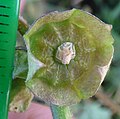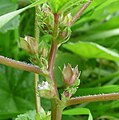Malva parviflora
| Malva parviflora | |
|---|---|
 | |
| Scientific classification | |
| Kingdom: | Plantae |
| Clade: | Tracheophytes |
| Clade: | Angiosperms |
| Clade: | Eudicots |
| Clade: | Rosids |
| Order: | Malvales |
| Family: | Malvaceae |
| Genus: | Malva |
| Species: | M. parviflora |
| Binomial name | |
| Malva parviflora L. | |
Malva parviflora is an annual or perennial herb that is native to Northern Africa, Southern Europe, and Western and Central Asia and is widely naturalised elsewhere.[1] Common names include cheeseweed,[1] cheeseweed mallow, Egyptian mallow,[1] least mallow,[2] little mallow,[1] mallow,[3] marshmallow,[3] small-flowered mallow,[4] small-flowered marshmallow[5] Nafa Shak and smallflower mallow.[3]
Description
M. parviflora has a decumbent or erect habit, growing up to 50–80 cm in height.[4][6] The broad leaves have 5 to 7 shallow lobes and are 8 to 10 cm in diameter.[4] The lobe edges are round toothed, with varying hairiness.[6] It has small white or pink flowers year-round at the base of leaf stalks; flowers have 4 to 10 mm long petals.[4][6] The 2 mm seeds are reddish-brown and kidney-shaped.[6]
Newly sprouted plants have hairless, heart-shaped cotyledons with long stalks. These cotyledons are 3–12 mm long and 3–8 mm wide. Stalks usually do have hairs. The first leaf is rounder and larger than the others. True leaves are round and weakly lobed with wavy, shallow-toothed edges and a red spot at the leaf base. The plant rapidly grows a deep taproot.[6]
M. parviflora leaf extracts possess anti-inflammatory and antioxidant activities.[7] In nitrogen-rich soils,[8] the plant's leaves and seeds can be toxic to cattle and poultry due to an accumulation of nitrates.[6]
M. parviflora has 2n=42 chromosomes.[9]
Taxonomy
Malva parviflora was described by Carl Linnaeus and published in Demonstrationes Plantarum in Horto Upsaliensi on October 3, 1753.[10]
- Etymology
The genus name “Malva”' is derived from Latin malva, -ae, a word used in Ancient Rome to refer to various types of mallow, primarily common mallow (Malva sylvestris), but also marshmallow (Althaea officinalis) and tree mallow (Malva arborea). Mallow was described, with its many virtues and properties, by Pliny the Elder in his Naturalis Historia (20, LXXXIV).[11][12] The species name “parviflora” means “of small flowers” and is a compound that comes from Latin parvum, -i, "small" (which in turn comes from Greek παύρος), and flora, from flos, -ris, "flower".
- Synonyms
- Malva flexuosa Hornem.
- Malva microcarpa Pers.
- Malva microcalyx C.A.Mey.
- Malva musiana Sennen
- Malva mareotica Delile ex DC.
- Malva coronata Pomel
- Malva bivoniana C.Presl
- Malva polycarpa Sennen
- Malva trionoides DC.
- Malva simpliciuscula Steud.
- Althaea mareotica Alef.
- Althaea microcarpa Alef.
- Althaea parviflora Alef.
- Malva heterocarpa Shuttlew.[10]
Distribution and Habitat
M. parviflora typically grows on agricultural lands and in disturbed sites such as roadsides.[6] Its native range extends from the Mediterranean, through West Asia, and to Central Asia and can be found in Algeria, Egypt, Libya, Morocco, Tunisia, Kuwait, Afghanistan, Cyprus, Iran, Israel, Jordan, Lebanon, Syria, Turkey, Armenia, Azerbaijan, Turkmenistan, Albania, Bosnia and Herzegovina, Greece, Croatia, Italy, Malta, Spain, France, and Portugal. The species is widely naturalized elsewhere,[1] including in North America since the 19th century.[8]
Uses
M. parviflora is sometimes used medicinally in infusions, cooking, or poultices as a laxative, moisturizer or antitussive.[9] In Mexico, M. parviflora is consumed as a quelite and used in traditional medicine to treat wounds, stomach problems such as gastritis, and problems with the liver, throat, and intestines.[13] The entire plant is edible and can be eaten both raw and cooked. It has a mildly green flavor similar to chard and a mild, earthy aroma.[8]
In the 20th century, naturalist Alfonso Herrera Fernández [es] mentioned that "the dried and pulverized leaves form a powder known as mallow flour which, alone or mixed with flaxseed flour, is used to make moisturizing poultices. The flowers are used in infusions as diaphoretics."[14]
Botanical gallery
-
 Plant, can become tall
Plant, can become tall -
 Plant from above showing leaves, flowers, fruits
Plant from above showing leaves, flowers, fruits -
 Flower white or pinky, petals gappy, approx same size as sepals, no hairs at petal bases
Flower white or pinky, petals gappy, approx same size as sepals, no hairs at petal bases -
 Flower within, showing staminal column and no petal hairs
Flower within, showing staminal column and no petal hairs -
 Maturing, 5-part sepals enlarge around like plate, fruit segments with wrinkled tops and wavy raised junctions (immature may look smooth)
Maturing, 5-part sepals enlarge around like plate, fruit segments with wrinkled tops and wavy raised junctions (immature may look smooth) -
 Fruit more mature
Fruit more mature - Fruit very mature, showing prominent wavy wings and wavy surfaces
-
 Fruits, on short stalks, not curving downwards
Fruits, on short stalks, not curving downwards -
 Sepals broad from the side, epicalyx 3 narrow strips at base
Sepals broad from the side, epicalyx 3 narrow strips at base -
 Flower from side showing large 5-part calyx, and 3 filamenty epicalyx coming from base
Flower from side showing large 5-part calyx, and 3 filamenty epicalyx coming from base -
 Hairs mostly stellate (star-shaped)
Hairs mostly stellate (star-shaped) -
 Large leaf
Large leaf -
 Leaf upperside
Leaf upperside -
 Leaf underside
Leaf underside
References
- ^ a b c d e "Malva parviflora". Germplasm Resources Information Network. Agricultural Research Service, United States Department of Agriculture. Retrieved 2008-06-02.
- ^ BSBI List 2007 (xls). Botanical Society of Britain and Ireland. Archived from the original (xls) on 2015-06-26. Retrieved 2014-10-17.
- ^ a b c "Malva parviflora". FloraBase. Western Australian Government Department of Biodiversity, Conservation and Attractions.
- ^ a b c d "New South Wales Flora Online: Malva parviflora". Royal Botanic Gardens & Domain Trust, Sydney, Australia.
- ^ "Malva parviflora L." Electronic Flora of South Australia Fact Sheet. State Herbarium of South Australia. Archived from the original on 2015-09-24. Retrieved 2008-06-03.
- ^ a b c d e f g "Little mallow (cheeseweed)". UC IPM. Regents of the University of California. Retrieved 17 May 2023.
- ^ Bouriche H, Meziti H, Senator A, Arnhold J"Anti-inflammatory, free radical-scavenging, and metal-chelating activities of Malva parviflora." Pharm Biol. 2011 May 19;
- ^ a b c "Foraged Mallow (Cheeseweed)". Specialty Produce. Retrieved 31 May 2024.
- ^ a b "Malva" (PDF). Flora Iberica. Retrieved 2024-05-20.
- ^ a b "Malva parviflora". WFO Plant List. Retrieved 31 May 2024.
- ^ B. Thayer, Pliny the Elder: the Natural History, Liber XX
- ^ Pline l'Ancien, Histoire naturelle, Liber XX, Traitant des remèdes fournis par les plantes de jardin. Texte français, Edition d'Émile Littré, Durocher, Paris 1848-1850
- ^ Mendiola Almaraz, Lorena (2005-04-29). "Análisis biodirigido de Malva parviflora para validar su uso tradicional como auxiliar en el tratamiento de la gastritis". Retrieved 2024-05-20.
- ^ "En Medicina tradicional mexicana". Retrieved 2024-05-20.
External links
 Media related to Malva parviflora at Wikimedia Commons
Media related to Malva parviflora at Wikimedia Commons- "Malva parviflora". Neotropical Herbarium Specimens. Archived from the original on 2016-03-03. Retrieved 2008-06-20.
- GBIF: Occurrence data for Malva parviflora
- Jepson Manual Treatment
- USDA Plants Profile
- Malva parviflora in the CalPhotos photo database, University of California, Berkeley
- "Malva parviflora". Calflora. Berkeley, California: The Calflora Database.
- "Malva parviflora". Plants for a Future.



























